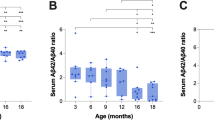Abstract
The cerebral accumulation of amyloid beta (Aβ) is one of the key pathological hallmarks of Alzheimer’s disease (AD). Aβ is also found in bodily fluids such as the cerebrospinal fluid (CSF) and plasma. However, the significance of Aβ accumulation in the brain and different bodily pools, as well as its correlation with aging and cerebral amyloid pathology, is not completely understood. To better understand this question, we selected the rhesus monkey, which is phylogenetically and physiologically highly similar to the human, as a model to study. We quantified the levels of the two main Aβ isoforms (Aβ42 and Aβ40) in different sections of the brain (frontal cortex, temporal cortex, and hippocampus) and bodily fluids (CSF and plasma) of rhesus monkeys at different developmental phases (young, 5–9 years of age; mature, 10–19 years of age; and old, 21–24 years of age). We found that the levels of neuronal and insoluble Aβ42 increased significantly in the brain with aging, suggesting that this specific isoform might be directly involved in aging and AD-like pathophysiology. There was no significant change in the Aβ40 level in the brain with aging. In addition, the Aβ42 level, but not the Aβ40 level, in both the CSF and plasma increased with aging. We also identified a positive correlation between Aβ42 in the CSF and plasma and Aβ42 in the brain. Taken collectively, our results indicate that there is an association between Aβ accumulation and age. These results support the increased incidence of AD with aging.





Similar content being viewed by others
References
Alzheimer’s Association (2015) 2015 Alzheimer’s disease facts and figures. Alzheimers Dement 11:332–384
Bennett DA, Schneider JA, Wilson RS, Bienias JL, Arnold SE (2004) Neurofibrillary tangles mediate the association of amyloid load with clinical Alzheimer disease and level of cognitive function. Arch Neurol 61:378–384
Chan KY, Wang W, Wu JJ, Liu L, Theodoratou E, Car J, Middleton L, Russ TC, Deary IJ, Campbell H, Wang W, Rudan I, the Global Health Epidemiology Reference Group (GHERG) (2013) Epidemiology of Alzheimer’s disease and other forms of dementia in China, 1990–2010: a systematic review and analysis. Lancet 381:2016–2023
Deyts C, Clutter M, Herrera S, Jovanovic N, Goddi A, Parent AT (2016) Loss of presenilin function is associated with a selective gain of APP function. eLife 5:e15645
Fagan AM, Head D, Shah AR, Marcus D, Mintun M, Morris JC, Holtzman DM (2009) Decreased cerebrospinal fluid Aβ42 correlates with brain atrophy in cognitively normal elderly. Ann Neurol 65:176–183
Fukumoto H, Rosene DL, Moss MB, Raju S, Hyman BT, Irizarry MC (2004) β-Secretase activity increases with aging in human, monkey and mouse brain. Am J Pathol 164:719–725
Giannakopoulos P, Herrmann FR, Bussiere T, Bouras C, Kovari E, Perl DP, Morrison JH, Gold G, Hof PR (2003) Tangle and neuron numbers, but not amyloid load, predict cognitive status in Alzheimer’s disease. Neurology 60:1495–1500
Gu L, Guo Z (2013) Alzheimer’s Aβ42 and Aβ40 peptides form interlaced amyloid fibrils. J Neurochem 126:305–311
Hellström-Lindahl E, Viitanen M, Marutle A (2009) Comparison of Aβ levels in the brain of familial and sporadic Alzheimer’s disease. Neurochem Int 55:243–252
Heuer E, Rosen RF, Cintron A, Walker LC (2012) Nonhuman primate models of Alzheimer-like cerebral proteopathy. Curr Pharm Des 18:1159–1169
Iqbal K, Liu F, Gong CX (2016) Tau and neurodegenerative disease: the story so far. Nat Rev Neurol 12:15–27
Kofler J, Lopresti B, Janssen C, Trichel AM, Masliah E, Finn OJ, Salter RD, Murdoch GH, Mathis CA, Wiley CA (2012) Preventive immunization of aged and juvenile non-human primates to β-amyloid. J Neuroinflammation 9:84
Kumar A, Singh A, Ekavali (2015) A review on Alzheimer’s disease pathophysiology and its management: an update. Pharmacol Rep 67:195–203
Nagase H, Nakayama K (2014) The intracellular domain of amyloid precursor protein is a potential therapeutic target in Alzheimer’s disease. Curr Drug Discov Technol 11:243–258
Norvin D, Kim G, Baker-Nigh A, Geula C (2015) Accumulation and age-related elevation of amyloid-β within basal forebrain cholinergic neurons in the rhesus monkey. Neuroscience 298:102–111
O’Brien RJ, Wong PC (2011) Amyloid precursor protein processing and Alzheimer’s disease. Annu Rev Neurosci 34:185–204
Qiu T, Liu Q, Chen YX, Zhao YF, Li YM (2015) Aβ42 and Aβ40: similarities and differences. J Pept Sci 21:522–529
Querfurth HW, LaFerla FM (2010) Alzheimer’s disease. N Engl J Med 362:329–344
Rosen RF, Walker LC, Levine H (2011) PIB binding in aged primate brain: enrichment of high affinity sites in humans with Alzheimer’s disease. Neurobiol Aging 32:223–234
Skaper SD (2012) Alzheimer’s disease and amyloid: culprit or coincidence? Int Rev Neurolbiol 102:277–316
Spies PE, Verbeek MM, van Groen T, Claassen JA (2012) Reviewing reasons for the decreased CSF Aβ42 concentration in Alzheimer’s disease. Front Biosci (Landmark Ed) 17:2024–2034
Woodruff-Pak DS (2008) Animal models of Alzheimer’s disease: therapeutic implications. J Alzheimers Dis 15:507–521
Zetterberg H, Blennow K, Hanse E (2010) Amyloid β and APP as biomarkers for Alzheimer’s disease. Exp Gerontol 45:23–29
Acknowledgments
This work was supported by the National Natural Science Foundation of China (Project Nos. 81200994 and 81571230) and the Science and Technology Project of Beijing Municipal Education Commission (Project No. KM20131002500231172293).
Authors’ Contributions
The concept and hypothesis were developed by BC, JL, and JW. Animal care and tissue collection were performed by QZ, LZ, and JL. Immunohistochemical staining and ELISA were performed by QZ, ZY, and SW. Data and statistical analysis were performed by QZ and BC. The paper was written by BC. All authors approved the final versions of the manuscript and figures.
Author information
Authors and Affiliations
Corresponding author
Ethics declarations
Conflicts of Interest
The authors declare that they have no conflicts of interest.
Additional information
Qiao Zhao and Jing Lu contributed equally to this work.
Rights and permissions
About this article
Cite this article
Zhao, Q., Lu, J., Yao, Z. et al. Upregulation of Aβ42 in the Brain and Bodily Fluids of Rhesus Monkeys with Aging. J Mol Neurosci 61, 79–87 (2017). https://doi.org/10.1007/s12031-016-0840-6
Received:
Accepted:
Published:
Issue Date:
DOI: https://doi.org/10.1007/s12031-016-0840-6




